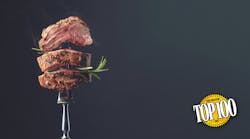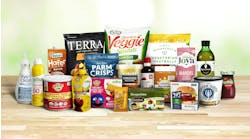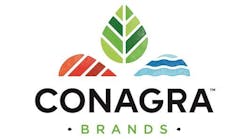2021 could be called the year of meat and soft drinks. All of the top companies in those two categories had blowout years, adding billions of dollars to their top lines and similarly handsome increases to their bottom lines.
Among all our Top 100© companies, the biggest sales increase by dollars belonged to JBS USA. The Brazilian-owned beef and pork company added nearly $5.8 billion in sales last year. Not far behind was PepsiCo, with a $4 billion jump. If there’s a common thread, it may be that restaurants and other foodservice markets – big accounts for both of those companies -- gradually came back to life in 2021 after a year blacked out by the pandemic.
This is our Top 100© report, an annual listing of the 100 largest food & beverage processors in the U.S. and Canada. Their 2021 financial results paint a picture of the general health of the industry and what shape they were in entering 2022.
Many of these companies saw sales jump as 2021’s pandemic restrictions were lifted; as a result, comparisons to their 2020 financials are questionable because of the negative effects of the pandemic in that year. Also worth noting, only a few of these numbers are exaggerated by the inflation that really took hold the beginning of this year.
Which is not to say there wasn’t price volatility in 2021. JBS’ Brazilian parent explained in its annual report, “In the U.S., availability of cattle remained adequate throughout the year but the average price, according to the USDA, showed an increase of 22% in 4Q21 vs, 4Q2020 and 13% in [all of] 2021 vs.2020 … Demand was driven by the strong performance in the retail channel and the recovery of the foodservice channel.
“Demand from Asia, which is now responsible for more than 75% of the total U.S. beef exports, remained strong,” JBS continued, “causing the global volume of U.S. beef exports in the year to exceed the volume exported in 2020 [by] more than 16%. The highlight continues to be China, which increases its share month after month.”
Over at PepsiCo, all business units did well, but the North American beverage unit was featured first in the annual report’s letter from Ramon Laguarta, chairman & CEO: “PepsiCo Beverages North America displayed superior execution and delivered 10% organic revenue growth, representing its fastest rate of organic revenue growth on an annual basis in over five years.”
“Changes in consumer behavior as a result of the COVID-19 pandemic contributed to a current-year increase in consumer demand, which had a positive impact on net revenue, unit volume and operating profit performance,” according to PepsiCo’s annual report.
In third place was Tyson, with an increase of $3.73 billion, and that was in a fiscal year that ended a little earlier than others in this report, Oct. 2, 2021; and it was compared to a 53-week fiscal year in 2020. “Sales grew 9% in fiscal 2021 … primarily due to increased average sales prices in each of our segments,” the annual report stated.
Sanderson Farms, in its final year as an independent company, added $1.2 billion in sales. Maybe more importantly, the poultry company went from a scant $28 million profit in 2020 to $455 million last year. That ought to please new owners Cargill, Continental Grain and Wayne Farms.
Sanderson executives explained in the annual report: “The significant improvement in our results is primarily attributable to significantly higher average selling prices for our products, partially offset by significantly higher costs of corn and soybean meal, our primary feed ingredients.”
2020 was a relatively flat year for the company, with Covid causing increased grocery sales of meat but a steep drop in foodservice accounts. While we weren’t out of the Covid woods entirely in 2021, by the end of the year sales were recovering, and in Sanderson’s case, helped by last year’s fast-food “chicken sandwich wars.”
“In mid-May 2020, the quoted price [for boneless chicken breast meat was] $1.58 per pound before falling to … $0.86 per pound by early October 2020, but by May 18, 2021, the price reached $2.26 per pound,” the Sanderson report continued. “As of December 17, 2021, the quoted market price is $2.13 per pound. We believe the strength that we have seen in the quoted market price is attributable, at least in part, to strong demand from quick-service restaurant chains that are featuring chicken products on their menus.”
Quick service restaurant customers snarfing those chicken sandwiches apparently washed them down with carbonated soft drinks. All the major beverage companies also performed well. In addition to that big bump for PepsiCo, Coca-Cola added $1.7 billion in sales and $2 billion in net income, and Keurig Dr Pepper increased sales by $680 million and net by $800 million.
Back to the meat side, Pilgrim’s Pride (80% owned by JBS) added more than $4 billion in sales. Canada’s Maple Leaf Foods grew by 20% (+$599 million) on a much smaller base. Hormel is much more than a meat company anymore, but it’s worth mentioning that their sales increased nearly $1.8 billion, although net income was flat.
Totaling up the first two columns (and subtracting Dreyer’s first-time figure), total food & beverage sales for this group increased by nearly $30 billion, up 5.6%. And net income for the whole group was up $16.8 billion, nearly 26%.
Food and Beverage's Winners & Losers in 2021
In addition to the meat and soft drink companies already mentioned, several companies had standout years.
Nestle’s U.S. and Canada operations added $1.3 billion in sales last year, and their Swiss parent increased profit by $5.4 billion. The new strategy must be working: “The evolution of our portfolio continued, focusing on categories with attractive growth opportunities and differentiated offerings,” read the annual report. “Recent examples include the acquisition of the core brands of The Bountiful Company and the divestiture of the mainstream water brands in North America.”
General Mills’ sales increased $1.2 billion, buoyed by market share gains in each of its five global platforms: cereal, pet food, ice cream, snack bars and Mexican food. Big G’s figures are for its fiscal 2022, which ended this May 31, so they also benefitted from this year’s inflation.
“Our positive market share performance amid pandemic-driven elevated demand for food at home helped drive organic net sales growth in our North America Retail, Europe & Australia, and Asia & Latin America segments,” the company wrote.
Hershey, half the size of General Mills, boosted sales 11%. In addition to good organic growth, acquisitions added high-growth brands like Pirates Booty, SkinnyPop and Dot’s Pretzels.
Arguably more important than sales is net income. Two companies that saw small dips in sales took leaps in improved profits. Anheuser-Busch InBev’s net was $4.67 billion, up from $1.4 billion in 2020. Kraft Heinz increased its net to $1.024 billion, up from just $361 million a year earlier.
Three companies reversed net losses from 2020. Molson Coors lost $949 million that year, the result of the pandemic’s shutdown of on-premise beer sales, but it turned a billion-dollar profit in 2021. Hain Celestial, which underwent a painful reorganization, lost $80 million in its fiscal 2020 but earned $77 million in FY2021, which ended June 30, 2021. Utz Brands, which just appeared on our radar in 2020, lost $108 million that year but pocketed $8 million last year.
However, three companies fell into the red in 2021: TreeHouse Foods (-$13 million), Grupo Lala (-$17 million) and SunOpta (-$4 million).
Totaling up the columns, 56 of these 100 companies increased sales in 2021 over 2020; only 15 had drops of more than 5%. 34 increased their net incomes while 17 reported lower profits.
While we’ve been doing this list for many years, every year a company or two join or drop from the list. This year we deleted Canada’s Weston Foods, which was dismantled late in 2021 by its grocery store parent, part being sold to Hearthside Food Solutions and part to FGF Brands.
New to the list is Dreyer’s Grand Ice Cream … which was on this list decades back until it was fully acquired by Nestle USA in 2002. As Nestle reconfigures its portfolio, it moved the ice cream business in December 2019 into Froneri, a joint venture the Swiss parent already had with PAI Partners. So now Dreyer’s looks like a standalone business.
Also growing just enough to make the list was SunOpta, debuting at No. 97, which bumped Sovos Brands off the chart.


